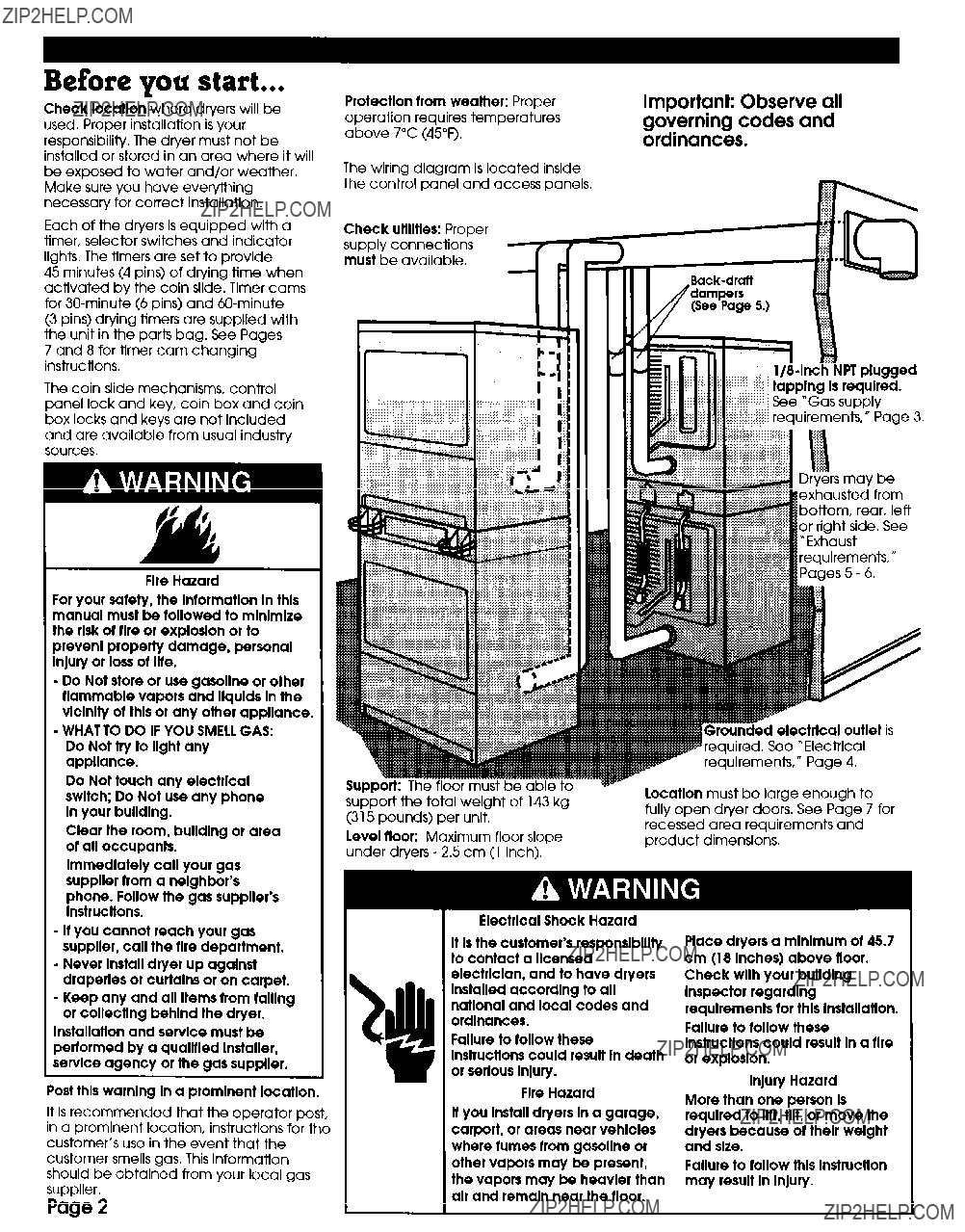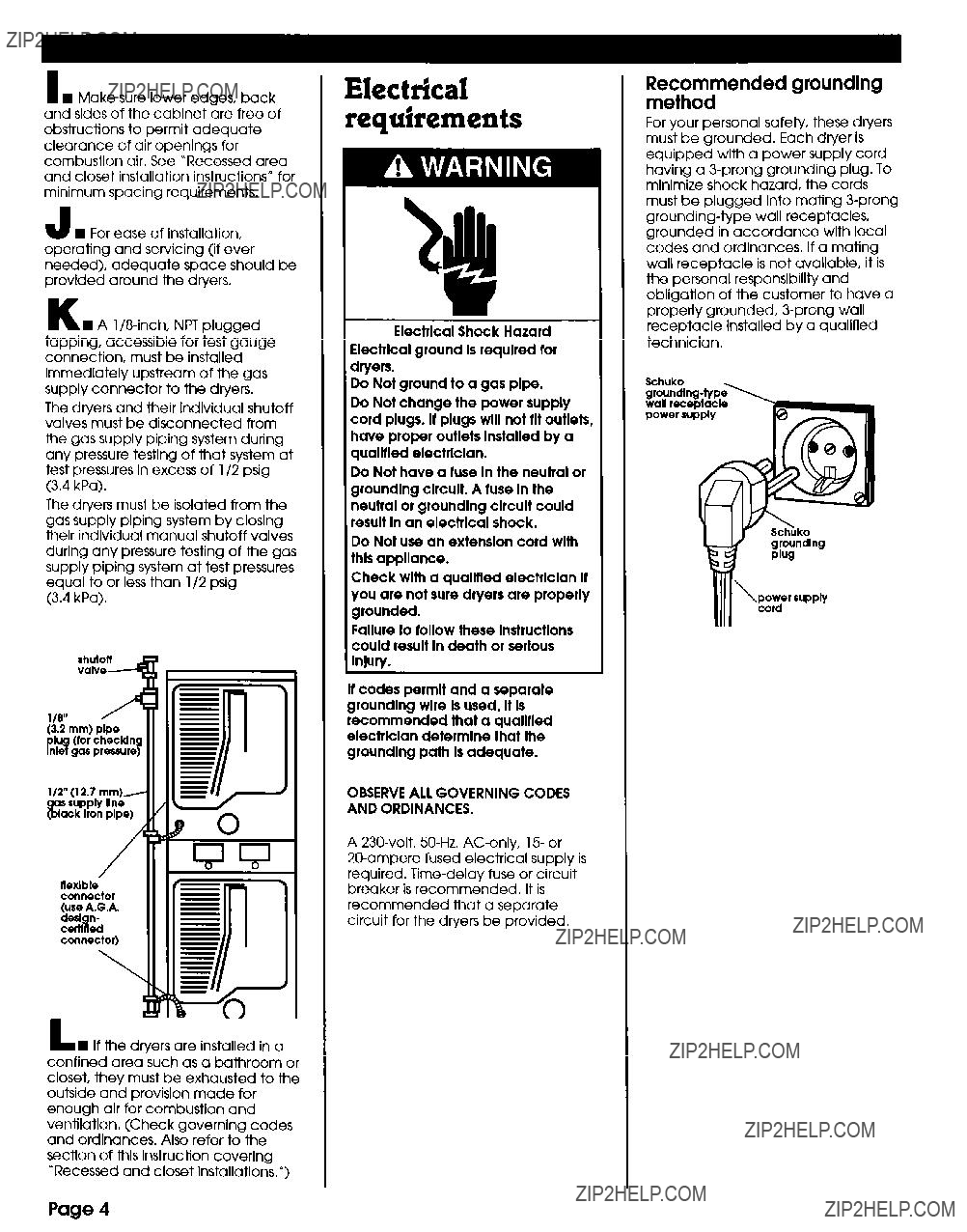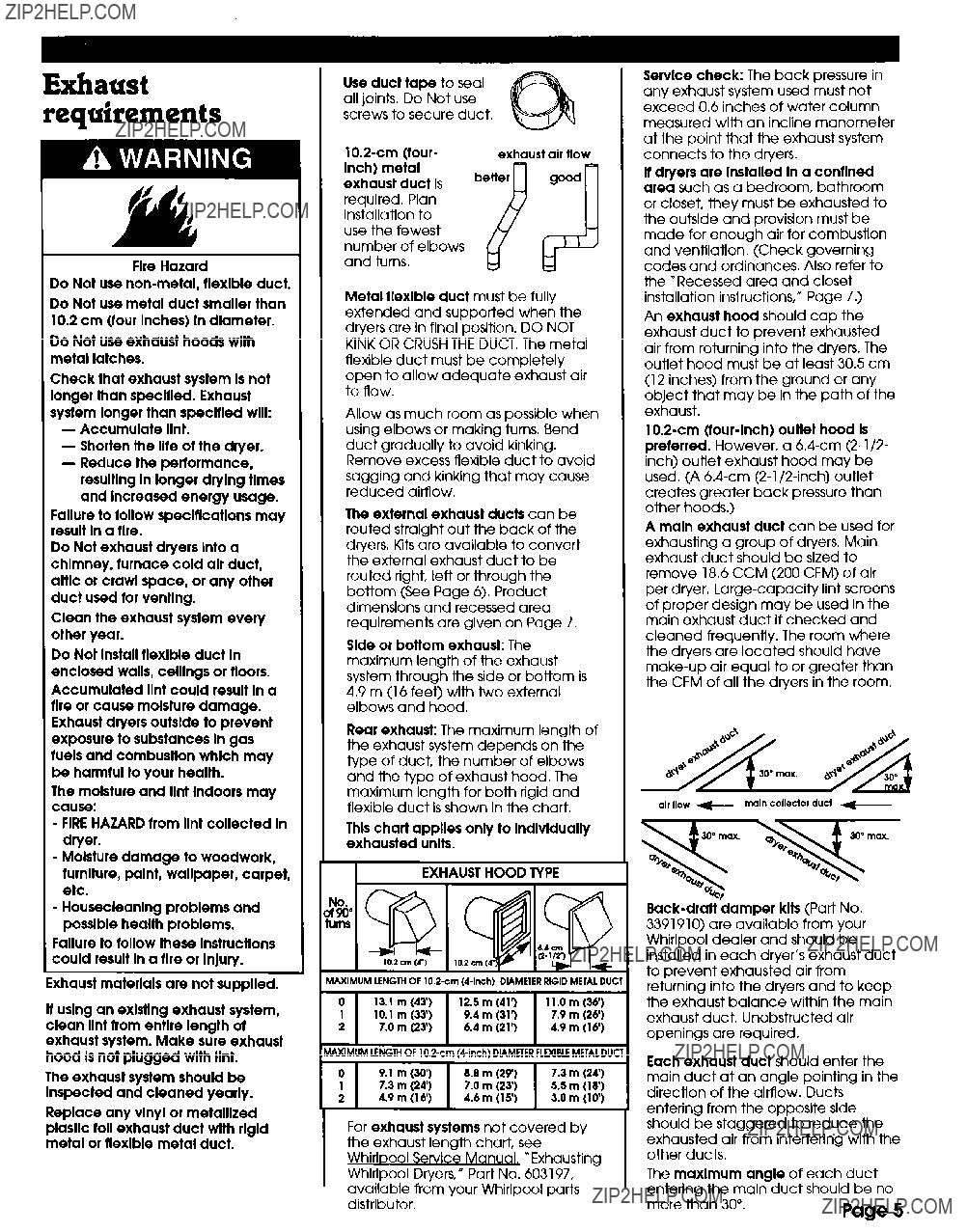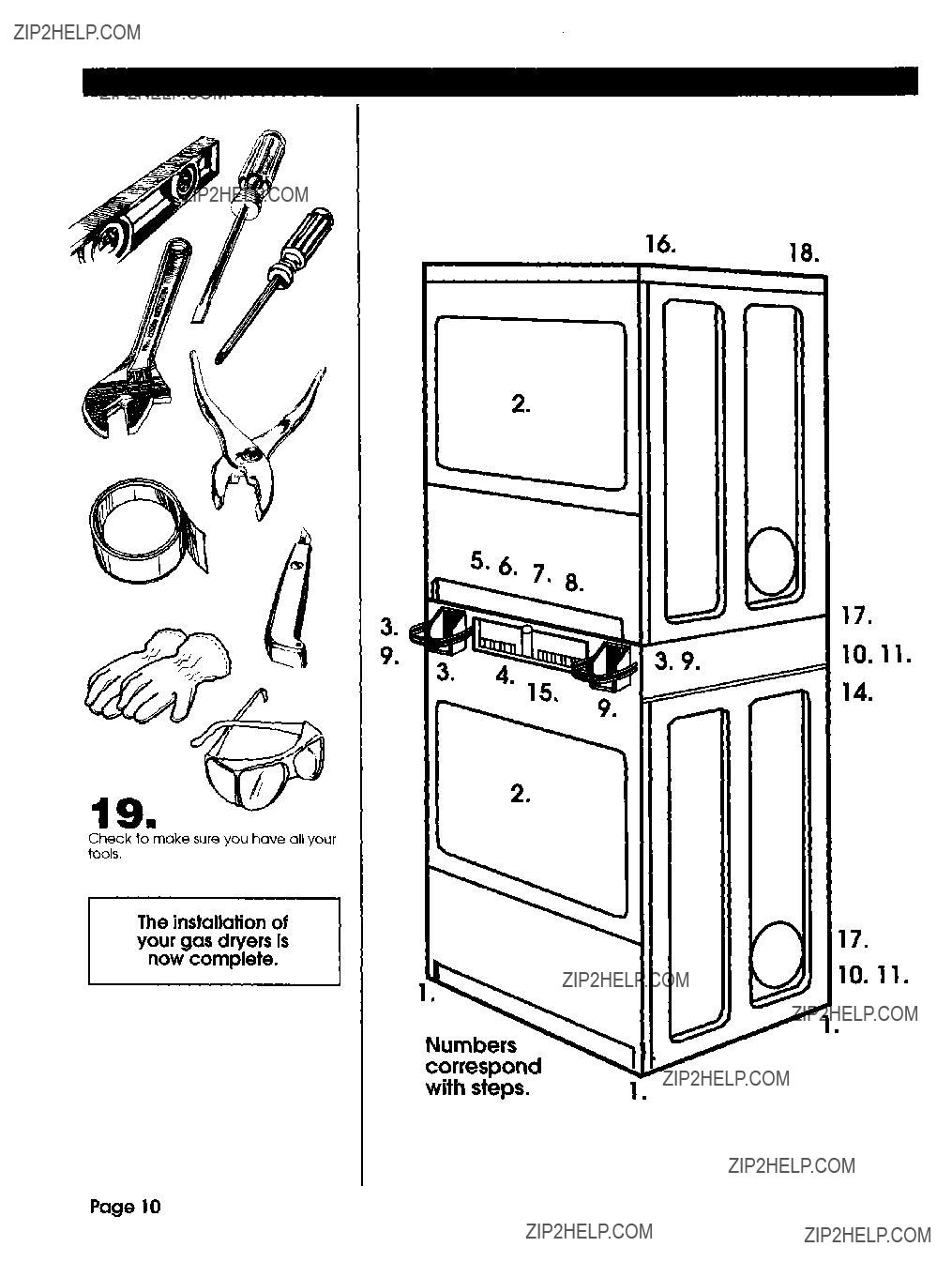
Stacked Dryers
Instructions
Part No. 3402328

Stacked Dryers
Instructions
Part No. 3402328

Before you start...
Check locatlon where dryers will be used. Proper installation is your responsibility. The dryer must not be installed or stored in an area where it will be exposed to water and/or weather. Make sure you have everything
necessary for correct installation.
Each of the dryers Is equipped with a timer, selector switches and indicator lights. The timers are set to provide
45 minutes (4 pins) of drying time when activated by the coin slide. Timer cams for
(3 pins) drying timers are supplied with the unit in the parts bag. See Pages
7 and 8 for timer cam changing instructions.
The
Protectlon from weather: Proper
operation requires temperatures above 7??C (45??F).
The wiring diagram is located inside the control panel and access panels.
Check utlllttes: Proper suoolv connections muit be available.
+t
Important: Observe all governing codes and ordinances.
l/&lncrkPT plugged tapplng Is required.
_...-
Dryers may be exhausted from
Fire Hazard
For your safety, the lnformatlon In thls manual must be followed to mlnlmlre the rlsk ot tlre or explosion or to prevent property damage, personal InJury or loss 0r iir8.
-Do Not store or use gasoline or other flammable vapors and llqulds In the vlclnlty ot thls or any other appliance.
-WHATTO DO IFYOU SMELLGAS:
Do Not try to light any appliance.
Do Not touch any electrlcal switch; Do Not use any phone In your bulldlng.
Clear the room, bulldlng or area 0r all occupants.
support the total welght of 143 kg (315 pounds) per unit.
Level floor: Maximum floor slope under dryers - 2.5 cm (1 inch).
;roun&d electrlcal outlet is
reauired. See ???Electrical requlrements,??? Page 4.
Locatlon must be large enough to fully open dryer doors. See Page 7 for recessed area requirements and Droduct dimensions.
lmmedlately call your gas suppller from a nelghbor???s phone. Follow the gas suppller???s Instructions.
-If you cannot reach your gas suppller, call the fire department.
-Never Install dryer up agalnst draperies or curtains or on carpet.
-Keep any and all Items from falling or collecting behlnd the dryer.
Installation and service must be performed by a qualltled Installer, service agency or the gas suppller.
J
Post thls warnlng In a promlnent locatlon.
It is recommended that the operator post, in a prominent location, instructions for the customer???s use in the event that the customer smells gas. This information
should be obtained from your local gas supplier.
Page 2
Electrlcal Shock Hazard
It Is the customer???s responslblllty to contact a licensed electrlclan, and to have dryers Installed according to all natlonal and local codes and ordinances.
Failure to tallow these lnstructlons could result In death or serious InJury.
Fire Hazard
If you Install dryers In a garage, carport, or areas near vehicles where fumes from gasoline or other vapors may be present, the vapors may be heavier than alr and remain near the rloor.
Place dryers a mlnlmum of 45.7 cm (18 Inches) above tloor. Check wlth your bulldlng Inspector regarding
requirements for thls Installation.
Failure to follow these lnstructlons could result In a fire or exploslon.
InJury Hazard
More than one person Is required to Iltt, tilt, or move the dryers because ot their welght and size.
Failure to follow thls lnstructlon may result In Injury.

Tools needed for installation:
supply:
1 control panel lock and key
2 coin vaults and keys (E.S.D. vault must have projecting lock.)
2
Parts may be ordered from Greenwald Industries, Inc. or Equipment Systems and Devices, Inc.
l Greenwald Industries, Inc.
1340 Metropolitan Avenue Brooklyn, NY 11237
telephone (7 18) 82
l Equipment Systems and Devices, Inc.
270 New Jersey Dr.
Fort Washington, PA 19034 telephone (215)
fax (215)
lMonarch P.O. Box 427
Gas supply reauhements
Fire Hazard
Dryers must be connected to a regulated gas supply.
Failure to do so could result In hlgh- pressure gas release, resulting In a fire or exploslon.
Have L.P.gas checked by a quallfled person bdore lnstalllng the dryer. The L.P.gas supply must not exceed 13 Inches water column pressure.
New, flexible tublng should be used. Reuslng old, flexible tublng mlght result In possible gas leaks.
Failure to follow these lnstructlons could result In flre or exploslon.
OBSERVEALL GOVERNING CODES
AND ORDINANCES.
A n This installation must conform with American National Standard, National Fuel Gas Code ANSI Z223.1- latest edition,* and all local codes and ordinances.
B n The desian of this drver has been certified by the American Gas Association for use at altitudes up to 3000 m (10.000 feet) above sea level at the B.T.U. rating indicated on the model/serial rating plate. Burner input adjustments are not required when the dryer is operated up to this elevation.
When installed above 3000 m (10,000 feet), a four percent (4%) reduction of the burner B.T.U. rating shown on the model/serial rating plate is required
for each 300 m (1 ,ooO foot) increase in elevation, For assistance when converting to other gas types and/or installing above 3000 m (10,000 feet) elevation, contact your local service company.
C n Check that dryers are equipped with the correct burner for the particular type of gas used. Burner information will be found on the rating plate in door well of the appliance. If thls information does not agree with the type of gas available, see your dealer.
D n These dryers are shipped for use with NATURAL GAS.
They are certified by the American Gas Association for
manufactured, mixed and L.P. (propane and butane) gases with appropriate conversion. No attempt shall be made to convert the appliance from the gas specified on the model/serial rating plate for use with a different gas without consulting the serving gas suppller. Converslon must be done by a quallfled service technlclan. Gas converslon klt part numbers are llsted on the gas valve burner base.
E n Provide a rlgld gas supply line
of
(20 feet), larger pipe will be needed. For L.P. gas usage,
approved copper tubing may be used.
F n If local codes and ordinances permit, it is recommended that new flexible metal tubing,
by the American Gas Association. be used for connecting the dryers to the gas supply line. (The gas feed pipe. which extends through the lower rear of each dryer, is provided with
G w The SUDDIV line shall be equipped with a manual shutoff
valve. This valve should be located in the same room as the dryers and should be in a location that allows ease of opening and closing. Do Not block access to shutoff valve.
H.
connec
main gas supply line, a combination of fittings must be used to obtaln an
Copies of the standards listed above may be obtained from:
*American Gas Association
11515 Wilson Boulevard
Arlington, Virginla 22209
Page 3

I n Make sure lower edges, back and sides of the cabinet are free of obstructions to permit adequate clearance of air openings for combustton air. See ???Recessed area and closet installation instructions??? for minimum spacing requirements.
J W For ease of installation, operating and servicing (if ever
needed), adequate space should be provided around the dryers.
K n A l/&inch, NPT pluaaed tapping, accessible for testgauge connection, must be installed immediately upstream of the gas supply connector to the dryers.
The dryers and their individual shutoff valves must be disconnected from the gas supply piping system during any pressure testing of that system at test pressures in excess of l/2 psig (3.4 kPa).
The dryers must be isolated from the gas supply piping system by closing their individual manual shutoff valves during any pressure testing of the gas supply piping system at test pressures equal to or less than l/2 psig
(3.4 kPa).
shutott valve
l/0???
(3.2mm) pipe plu (for check1 Me7 gas pressure
l/2??? (I 2.7mm), as supply Ine $ lock Iron pipe)
/
ttexlble connector (useA.G.A. desl n- certl1ed connector)
L n If the dryers are installed in a confined area such as a bathroom or closet, they must be exhausted to the outside and provislon made for enough air for combustion and ventilation. (Check governlng codes and ordinances. Also refer to the sectlon of thls Instruction covering ???Recessed and closet Installations.???)
Electrical
reauirements
a
Electrlcal Shock Hazard Electrlcal ground Is required for
dprs.
Do Not ground to a gas pipe.
Do Not change the power supply cord plugs. If plugs will not flt outlets have proper outlets Installed by a quallfled electrlclan.
Do Not have a fuse In the neutral or groundlng clrcult. A tuse In the neutral or groundlng clrcult could result In an electrlcal shock.
Do Not use an extension cord wlth this appliance.
Check wlth a quallfled electrlclan If you are not sure dryers are properly grounded.
Failure to follow these lnstructlons could result In death or serious Injury.
If codes permit and a separate groundlng wire Is used, It Is recommended that a qualltled electrlclan determlne that the groundlng path Is adequate.
OBSERVEALL GOVERNING CODES
AND ORDINANCES.
A
circuit for the dryers be provided.
Kgrdmended grounding
For your personal safety, these dryers must be grounded. Each dryer is equipped with a power supply cord having a
Schuko .
Page 4

Exhaust
requirements
Fire Hazard
Do Not use
Do Not use exhaust hoods wlth metal latches.
Check that exhaust system Is not longer than specltled. Exhaust system longer than speclfled will:
-Accumulate Ilnt.
-Shorten the llfe ot the dryer.
-Reduce the performance, resulting In longer drylng times and Increased energy usage.
Failure to r0ii0w specltlcatlons may result In a tire.
Do Not exhaust dryers Into a chimney, turnace cold alr duct, alilc or crawl space, or any other duct used ror ventlng.
Clean the exhaust system every other year.
Do Not Install tlexlble duct In enclosed walls, celllngs or floors.
Accumulated lint could result In a fire or cause moisture damage. Exhaust dryers outslde to prevent exposure to substances In gas tuels and combustion which may be harmful to your health.
The moisture and llnt Indoors may cause:
-FIREHAZARDtram llnt collected In dryer.
-Moisture damage to woodwork, furniture, palnt, wallpaper, carpet, etc.
-Housecleanlng problems and possible health problems.
Failure to tallow these lnstructlons could result In a tlre or Inlury.
ixhaust materials are not supplled.
It uslng an exlstlng exhaust system, clean llnt from entlre length ot exhaust system. Make sure exhaust hood Is not plugged wlth Ilnt.
The exhaust system should be Inspected and cleaned yearly.
Replace any vlnyl or metalllzed plastic toll exhaust duct wlth rlgld metal or tlexlble metal duct.
Use duct tape to seal all joints. Do Not use screws to secure duct.
Metal tlexlble duct must be fully extended and supported when the dryers are in final position, DO NOT KINK OR CRUSH THE DUCT. The metal flexible duct must be completely
open to allow adequate exhaust air to flow.
Allow as much room as possible when using elbows or making turns. Bend duct gradually to avoid kinking. Remove excess flexible duct to avoid sagging and kinking that may cause reduced airflow.
The external exhaust ducts can be routed straight out the back of the dryers. Kits are available to convert the external exhaust duct to be routed right, left or through the bottom (See Page 6). Product dimensions and recessed area requirements are given on Page 7.
Slde or bottom exhaust: The maximum length of the exhaust system through the side or bottom is 4.9 m (16 feet) wlth two external elbows and hood.
Rear exhaust: The maximum length of the exhaust system depends on the type of duct, the number of elbows and the type of exhaust hood. The maximum length for both rigid and flexible duct is shown in the chart.
Thls chart applies only to lndlvldually exhausted unlts.
WIMUM LENGTH OF 10.2~cm
AXIMUM IfNGiH OF 10.2~cm
For exhaust systems not covered by the exhaust length chart, see WhirtDool Service Manual, ???Exhausting Whirlpool Dryers,??? Part No. 603197, available from your Whirlpool parts distributor.
Service check: The back pressure in any exhaust system used must not exceed 0.6 inches of water column measured with an incline manometer at the point that the exhaust system connects to the dryers.
If dryers are Installed In a conflned area such as a bedroom, bathroom or closet, they must be exhausted to the outslde and provislon must be made for enough air for combustion and ventilation. (Check governing codes and ordinances. Also refer to the ???Recessed area and closet installation instructions,??? Page 7.)
An exhaust hood should cap the exhaust duct to prevent exhausted
air from returning into the dryers. The outlet hood must be at least 30.5 cm (12 inches) from the ground or any object that may be in the path of the exhaust.
A maln exhaust duct can be used for exhausting a group of dryers. Main exhaust duct should be sized to remove 18.6 CCM (200 CFM) of air per dryer.
Each exhaust duct should enter the main duct at an angle pointing in the direction of the airflow. Ducts
entering from the opposite side should be staggered to reduce the exhausted alr from interfering with the other ducts,

Keep air openlngs free ot dry- cleaning fluld fumes. Fumes create acids which, when drawn through the dryer heatlng unlts, can damage dryers and loads being drled.
A
An exhaust hood should cap the outside end of the main duct to prevent exhausted air from returning to the dryers. If an exhaust hood cannot be used, the outside end of the main duct should have a sweep elbow directed downward. If the main duct travels vertically through the roof rather than through the wall, install 180??? sweep elbow on the end of duct at least 61 cm (2 feet) above the highest part of the building. The opening wall or roof shall have a diameter 1.3 cm (l/2 inch) larger than the exhaust duct diameter. The exhaust duct should be centered in the opening.
Do Not install screening cap over end of duct.
Exhaust duct connection
Determine which direction you need to attach the exhaust ducts to the dryers, Both dryers can be exhausted straight out the back or from the right or left side. The lower dryer can also be exhausted through the bottom.
Next, determine the length of exhaust duct you will need to connect the dryers to exhaust hoods or the main exhaust.
To connect exhaust duct straight out the back -
Attach exhaust duct to each dryer duct. Then connect exhaust ducts to exhaust hoods or main exhaust. Use duct tape to seal all joints.
To connect exhaust duct to the right, left or bottom -
Use one of the following kits to convert the dryers. Follow kit instructions to avoid operating problems.
Exhaust Kit No. 279818 (White)
Exhaust Kit No. 279819 (Almond)
Recessed area and closet installations
Fire Hazard Dryers MUSTbe exhausted to Wslde.
20 Not exhaust dryers Into a
4chimney, turnace cold alr duct, attlc tor crawl space, or any other duct used tar ventlng.
Failure to tallow these lnstructlons could result In a flre.
i
Stacked dryers may be Installed In a recessed area.
The installation spacing is in centimeters and inches and is the minimum allowable. Additional spacing should be considered for ease of installation, servicing and compliance with local codes and ordinances.
If closet door is installed, the mlnimum unobstructed air openings in the top and bottom are required. Door must have two centered openings as illustrated. Both openings must provide a minimum of 465 sq cm
(72 square inches) of unobstructed airflow as shown. Louvered doors with equivalent air openlngs are
acceptable.
FORCLOSETINSTALLATIONS,TO
PREVENTLARGEAMOUNTS OF LINT
AND MOISTUREFROM
ACCUMULATING, TO MAINTAIN
DRYING EFFICIENCY,AND TO PREVENT
EXPOSURETO POSSIBLEHEALTH
HAZARDS,DRYERSMUSTBEEXHAUSTED
OUTDOORS.
It yoy q
recessed front view
(I
Addlttonal clearances may be required for wall, door and floor moldtngs It external exhaust elbow Isused.
Page 6

Ocmj (0???)
closet side view
0
Additional space may be needed for exhaust elbow. Additional clearances fog wall, door and floor moldings may be required.
installed in the same closet.
Product dimensions
F???
side view
I
191 CIn
c
-
approx, 2.5 cm
(1???)
rear
view I3 34.9 cm
2.5 cmJ
(1???3, IFi&
et
118.7???cm I,
cm
cm (4???)
17.1 cm
To than e to a 30- or 6$
Electrlcal Shock Hazard
Disconnect both power supply cords betore changing timer cams.
Failure to tallow thls lnstructlon could result In death or serlous Injury.
Each dryer is equipped with a 45 minute tlmer cam that provides 45 minutes of drying time when activated by the coin slide.
You can install the
1. Unlock control panel. Lift up and rotate out from cabinet. Control panel will still be attached to cabinet.
2. Reach into control panel area. Use a Phillips screwdriver to loosen @ut
not remove) timer mounting bracket screw. Lift up to remove timer assembly and bracket from cabinet.
timing cam
3. Turn the timing cam by hand until me
Page 7

to clear
ratchet tooth.
4.Insert a narrow,
5.Place new cam (hub side down) over clock shaft. Line up flat side of shaft with flat side of cam hole.
Check that drive lug is in place,
6.Turn cam until
7.Press cam down in place on motor shaft. Make sure that
notch clears the ratchet tooth,
8.Reattach the timer bracket assembly; tighten the screws.
9.Repeat steps for other timer.
10.Close and lock the control panel.
Now start...
With dryers in laundry area.
1 n
Put on gloves and safety glasses. Check that each leg is approximately 2.5 cm (1 inch) from base.
2.
Wipe the interior of the drums thoroughly with a damp cloth.
3.
Install coin vaults and locks (not supplied) into meter case openings.
4.
Install control panel lock and key (not supplied).
5.
If you wish to change the
Open control panel and rest it on the bottom edge of the opening. Attach slide extension (with flange pointing down) to one of the
7.
Secure
8.
Repeat Steps 6 and 7 for the other
l
i
9.
Insert top of wire guard into holes on each side of the
mechanism. Insert screws through hooked ends of guard and tighten. Repeat for other wire guard.
Page 8

Remove the red caps from the gas pipes.
11.
Connect gas supply to each dryer. Use
12.
Open the shutoff valves in the gas supply lines.
Fire Hazard
Do Not use an open flame to test tar leaks from gas connectlons.
Checking for leaks wlth a flame may result In a tire or explosion.
13.
Use a brush and liquid detergent to test all gas connections for leaks. Bubbles around connections will indicate a leak. If a leak appears,
shut off gas valve controls and adjust connections. Then check
connections again. NEVERTESTFOR GAS LEAKSWITHA FLAME. Close the access panels.
All connectlons must be wrench- tightened.
Plug power supply cords into grounded outlets, Turn on electrical power supply.
Betore movlng dryers across floor, slide dryers onto cardboard or hardboard to protect rloor coverlng.
Move unit to its permanent location.
15.
Turn one dryer on to remove air from the gas supply line. Using a full heat cycle (not the air cycle), let the dryer run for at least five minutes. If the burner does not ignite and you can feel no heat inside the dryer, shut off the dryer for five minutes. Check that all supply valve controls are In ???ON??? position and that the power supply cord is plugged in. Repeat the five- minute test.
16 n
Check levelness of dryers by placing a carpenter???s level on top of the dryers or collar, first side to side, then front to back. If dryer Is not level. adjust the front legs up or down. Make the final check with the level.
17.
To exhaust the dryers, see ???Exhaust requirements??? and ???Exhaust duct connection,??? Pages 5 and 6.
Injury Hazard
To prevent tlpplng, tether bracket must be secured to wall studs or concrete wall.
Failure to do so could result In InJury.
tether bracket lo at rear of the top
Attach both ends of tether located at the rear of the top, drver, to a secured
2 x4.
Page 9


If dryers do not
operate properly...
Check the followlng to be sure that:
1.Electrical supply is connected.
2.Circuit breakers are not tripped or fuses blown.
3.Doors are closed.
4.Timer has been actuated.
5.Controls are set in a running or ???ON??? position,
6.Gas shutoff valves are open both on dryer and supply Ilne.
Move dryers to a
new location...
Before movlng dryers across tloor, slide dryers onto cardboard or hardboard to protect tloor coverlng.
l Shut off electrical supply to dryers.
l Disconnect power supply cords and tape securely to dryer.
l Shut off the gas supply valves in the gas supply line.
l Disconnect gas pipe and fittings from dryer and cap the gas supply line. Tape end of dryer gas pipes.
l Tape the drums to the front panel. l Tape doors to cabinet.
l Adjust leveling legs all the way in.
Before installing dryers in a new location, check with your gas supplier or dealer to see that your dryer is equipped with the correct burner for the particular type of gas in your new building. Burner informatlon may be found on the model/serial rating
plate in the door well of the dryer.
Page 11
